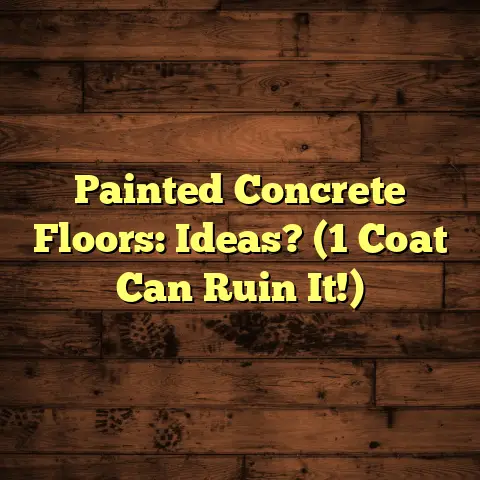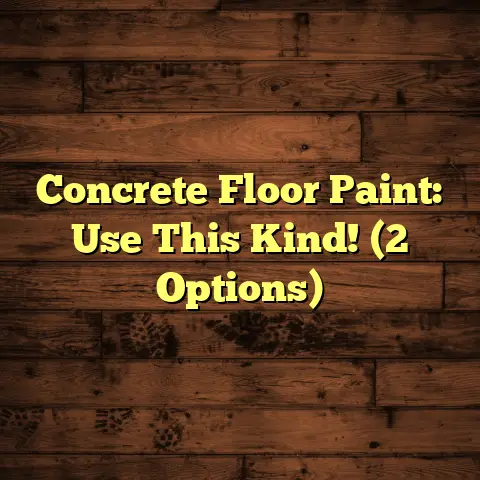Fix Water-Warped Wood Floors? (3 Steps, Act Now!)
Ever walked into your house and felt that pang of disappointment? It’s seeing your beautiful wood floors looking… well, sad. Water damage is a real bummer, isn’t it?
I’ve seen it all in my years as a flooring contractor. Buckling, cupping, warping – you name it, I’ve dealt with it. And let me tell you, ignoring it is not the answer.
But don’t panic! I’m here to tell you that you don’t necessarily need to rip everything out and start over. There’s hope! With the right approach, you can restore your floors and bring back that warm, inviting feeling.
I’m going to walk you through a simple, 3-step process that I’ve used countless times. It’s all about acting fast and smart.
Ready to get started? Let’s dive in!
Section 1: Understanding Water-Warped Wood Floors
Definition and Causes
So, what exactly are water-warped wood floors? Simply put, it’s when your hardwood gets damaged due to excessive moisture.
Think of it like a sponge. Wood absorbs water, and when it does, it expands. When it dries, it shrinks. This constant expansion and contraction can cause all sorts of problems.
Here’s a breakdown of common causes:
-
Leaks: These are the usual suspects. Think leaky pipes, overflowing washing machines, or even a roof that’s seen better days. Even a small, slow leak can cause major damage over time.
-
Spills: We’ve all been there. A glass of water tips over, or the dog knocks over his water bowl. Clean it up quickly, but sometimes the damage is already done if it seeps into the seams.
-
Humidity: This is a sneaky one. High humidity, especially in basements or bathrooms, can cause wood to absorb moisture from the air. This is more common in older homes or those with poor ventilation.
-
Flooding: Obvious, but worth mentioning. Whether it’s from a natural disaster or a burst pipe, flooding can saturate your floors and cause severe warping.
The result? You might see your floors:
- Swelling: Boards become thicker than normal.
- Buckling: The floor lifts up in the middle.
- Cupping: The edges of the boards rise, creating a trough-like shape.
- Crowning: The opposite of cupping; the center of the board is raised.
Signs of Water Damage
Okay, so how do you know if you have a problem? Keep an eye out for these telltale signs:
-
Visible Warping: This is the most obvious sign. Look for boards that are no longer flat or even. You might notice dips, humps, or edges that are raised.
-
Discoloration: Water can stain wood, leading to dark spots, light patches, or even a grayish tinge. This is especially common around seams and edges.
-
Mold Growth: A nasty sign, but important to catch. Mold loves damp environments, so if you see any fuzzy growth, especially in corners or under baseboards, you’ve got a moisture problem.
-
Musty Odor: That damp, earthy smell? That’s likely mold or mildew growing under your floors. Don’t ignore it!
-
Squeaking: While some squeaking is normal, excessive squeaking, especially in certain areas, can indicate that the subfloor is damp or damaged.
-
Changes in Finish: The finish on your floors might start to peel, crack, or bubble if it’s exposed to too much moisture.
Imagine this: You’re walking barefoot across your living room. Suddenly, you feel a slight bump under your feet. You look down and notice that one of the boards is slightly raised. That’s a red flag!
Or picture this: You’re cleaning your bathroom and notice a dark stain spreading across the floor near the toilet. That’s another sign that water is seeping into your wood.
Importance of Timely Action
Why is it so important to address water-warped wood floors quickly? Because the longer you wait, the worse the problem gets.
Here’s what can happen if you procrastinate:
-
Further Damage: The warping can worsen, leading to cracks, splits, and even structural damage to the subfloor.
-
Mold and Mildew: As I mentioned earlier, mold thrives in damp environments. It can spread quickly, causing health problems and requiring expensive remediation.
-
Costly Repairs: The longer you wait, the more extensive the repairs will be. What might have been a simple fix can turn into a full-blown floor replacement.
-
Health Risks: Mold and mildew can trigger allergies, asthma, and other respiratory problems. It’s not something you want to mess around with.
-
Reduced Home Value: Water damage can significantly decrease the value of your home. If you’re planning to sell, you’ll need to disclose the problem, which can scare off potential buyers.
Let me give you a real-world example. I once worked on a house where the homeowners ignored a small leak under their kitchen sink for months. By the time they called me, the water had seeped into the subfloor, causing extensive rot and mold growth. The entire kitchen floor had to be torn out and replaced, costing them thousands of dollars.
Don’t let that happen to you! Addressing water damage early can save you time, money, and a whole lot of headaches.
Section 2: Step 1 – Assessing the Extent of Damage
Alright, so you suspect you have water-warped floors. Now what? The first step is to figure out just how bad the damage is. This is where your detective skills come in handy!
Visual Inspection
Grab a flashlight and get down on your hands and knees. It’s time to give your floors a thorough once-over.
Here’s what to look for:
-
Warping: Pay close attention to the shape of the boards. Are they cupped, crowned, or buckled? How many boards are affected?
-
Discoloration: Look for any changes in color, such as dark spots, light patches, or grayish areas. Where is the discoloration located?
-
Mold Growth: Check for any fuzzy growth, especially in corners, under baseboards, and around plumbing fixtures.
-
Cracks and Splits: Look for any cracks or splits in the wood. Are they hairline cracks or larger, more significant breaks?
-
Loose Boards: Gently try to wiggle individual boards. Are any of them loose or easily moved?
-
Water Stains on Walls: Check the baseboards and walls for water stains, which can indicate a leak.
-
Check Under Appliances: Pull out your refrigerator, dishwasher, and washing machine to check for leaks and water damage.
Don’t just focus on the obvious areas. Water can travel under baseboards and through cracks, so be sure to inspect every nook and cranny.
Testing for Moisture
Visual inspection is a good start, but it’s not always enough. Sometimes, water damage is hidden beneath the surface. That’s where moisture testing comes in.
Here are a couple of methods you can use:
-
Moisture Meter: This is the most accurate way to measure moisture levels in wood. You can rent or buy a moisture meter at most home improvement stores. Simply press the probes into the wood and get a reading.
-
Target Moisture Levels:
- Wood subfloors should be between 6-12% moisture content.
- Wood flooring should be between 6-9% moisture content.
-
Here’s a table showcasing acceptable moisture levels:
Material Acceptable Moisture Level Wood Subfloors 6-12% Wood Flooring 6-9% Concrete Slabs Below 4%
-
-
Plastic Sheet Test: This is a simpler, less accurate method, but it can still give you a general idea of moisture levels. Tape a square of plastic wrap (about 1 foot by 1 foot) to the floor in the affected area. Leave it in place for 24-48 hours. If moisture condenses under the plastic, it means there’s still moisture in the floor.
According to the EPA, the acceptable moisture permeance for concrete slabs is less than 3 lbs per 1000 sq ft over 24 hours.
When testing for moisture, be sure to test multiple areas, including:
- The most visibly damaged areas
- Areas near potential sources of water (e.g., pipes, appliances)
- Areas that appear to be unaffected
It’s also important to test the subfloor, if possible. This will give you a better understanding of the overall moisture situation.
Documenting Findings
As you inspect and test, take detailed notes and photos. This will help you track the extent of the damage and monitor your progress as you dry and repair the floors.
Here’s what to document:
-
Location of Damage: Note the specific areas where you see warping, discoloration, or mold. Use landmarks (e.g., “near the toilet,” “under the window”) to help you remember the exact locations.
-
Type of Damage: Describe the type of damage you see (e.g., “cupping,” “buckling,” “mold growth”).
-
Severity of Damage: Rate the severity of the damage on a scale of 1 to 10 (1 being minor, 10 being severe).
-
Moisture Levels: Record the moisture readings you get with your moisture meter.
-
Photos: Take clear, well-lit photos of all the damaged areas. Use a ruler or other object to provide scale.
Create a simple spreadsheet or document to organize your findings. This will be invaluable as you move on to the next steps.
Section 3: Step 2 – Drying the Affected Area
Okay, you’ve assessed the damage. Now it’s time to get to work! The most crucial step in fixing water-warped floors is to dry them out thoroughly. Water is the enemy here, and the faster you remove it, the better.
Immediate Actions
As soon as you discover water damage, take these immediate steps:
-
Stop the Source of Water: This is priority number one! If you have a leak, turn off the water supply or call a plumber immediately.
-
Remove Furniture and Rugs: Get everything off the affected area. This will allow air to circulate and help the floors dry faster.
-
Open Windows and Doors: If the weather permits, open windows and doors to improve ventilation.
-
Use Fans: Place fans around the affected area to circulate air and speed up drying. Position the fans so they blow air across the surface of the floors.
-
Use Dehumidifiers: Dehumidifiers will help remove moisture from the air. Place them in the affected area and set them to the lowest humidity setting.
-
Wipe Up Excess Water: Use towels or a wet/dry vacuum to remove any standing water. Be sure to dispose of the towels properly to prevent mold growth.
-
Remove Wet Items: If any items (e.g., rugs, furniture) have gotten wet, remove them from the area and dry them thoroughly. If they can’t be dried, dispose of them to prevent mold growth.
I can’t stress enough how important it is to act quickly. The faster you remove the water and start drying the floors, the less damage you’ll have to deal with.
Long-Term Drying Solutions
If the water damage is severe or widespread, you may need more extensive drying solutions.
Here are a few options:
-
Pulling Up Floorboards: If the damage is localized, you can carefully remove the affected floorboards to allow the subfloor to dry. This is best done by a professional, as it can be tricky to remove the boards without damaging them.
-
Professional Drying Services: If the damage is extensive, consider hiring a professional drying service. They have specialized equipment, such as industrial-strength dehumidifiers and air movers, that can dry your floors quickly and effectively. They can also monitor moisture levels and ensure that the drying process is complete.
-
Subfloor Ventilation: If the subfloor is damp, you may need to improve ventilation. This can involve installing vents or fans to circulate air under the floors.
-
Thermal Imaging: Professionals use thermal imaging cameras to detect hidden moisture behind walls and under floors.
-
Desiccant Dehumidifiers: These are more powerful than standard dehumidifiers and are often used in commercial drying applications.
When drying your floors, it’s important to be patient. It can take several days or even weeks for the floors to dry completely, depending on the severity of the damage.
Monitoring Progress
As you dry your floors, it’s important to monitor your progress. This will help you determine when the drying process is complete and whether you need to take any additional steps.
Here’s what to monitor:
-
Moisture Levels: Use your moisture meter to check moisture levels in the wood and subfloor regularly. Aim for moisture levels that are within the acceptable range (6-9% for wood flooring, 6-12% for wood subfloors).
-
Visual Changes: Keep an eye on the appearance of the floors. Are the boards starting to flatten out? Is the discoloration fading?
-
Odor: Is the musty odor disappearing?
-
Temperature and Humidity: Monitor the temperature and humidity in the room. Aim for a temperature of 60-80°F and a humidity level of 30-50%.
Keep a log of your observations and moisture readings. This will help you track your progress and identify any potential problems.
If you’re not seeing progress after a few days, or if the moisture levels are still high, you may need to adjust your drying methods. Consider adding more fans or dehumidifiers, or consult with a professional drying service.
Section 4: Step 3 – Repairing and Restoring the Floors
Alright, you’ve dried out your floors. Now it’s time to repair the damage and restore them to their former glory. This is where you get to see the fruits of your labor!
Minor Repairs
If the warping is minor, you may be able to repair the floors without replacing any boards.
Here are a few techniques you can try:
-
Using Weights to Flatten Cupped Boards: If the boards are cupped, you can try to flatten them by placing heavy weights on top. Use sandbags, books, or other heavy objects. Cover the boards with a towel or cloth to protect them from scratches. Leave the weights in place for several days or even weeks.
-
Sanding Down Raised Areas: If the boards are raised in certain areas, you can try sanding them down to create a smooth, even surface. Use a drum sander or orbital sander with a medium-grit sandpaper. Be careful not to sand too much, as you could damage the finish.
-
Filling Cracks and Gaps: Use wood filler to fill any cracks or gaps in the floorboards. Choose a wood filler that matches the color of your floors. Apply the filler with a putty knife and smooth it out. Let the filler dry completely before sanding it smooth.
-
Applying a New Finish: Once you’ve made the repairs, you’ll need to apply a new finish to the floors. This will protect the wood and give it a uniform appearance. Choose a finish that is appropriate for your type of wood and the level of traffic it receives.
Here’s a step-by-step guide for sanding down raised areas:
- Prepare the area: Clean the floor thoroughly and remove any loose debris.
- Set up the sander: Attach a medium-grit sandpaper (e.g., 80-grit) to your sander.
- Sand the raised area: Gently sand the raised area, moving the sander in the direction of the wood grain. Be careful not to sand too much, as you could damage the finish.
- Switch to a finer grit: Once the raised area is level with the surrounding floor, switch to a finer-grit sandpaper (e.g., 120-grit) to smooth out the surface.
- Clean the area: Remove any sanding dust with a vacuum or damp cloth.
- Apply a new finish: Apply a new finish to the sanded area, following the manufacturer’s instructions.
Replacing Severely Damaged Boards
If the warping is severe or the boards are cracked or split, you’ll need to replace them.
Here’s how to do it:
-
Remove the Damaged Board: Carefully remove the damaged board using a chisel and hammer. Be careful not to damage the surrounding boards.
-
Prepare the Subfloor: Clean the subfloor and remove any debris. Make sure the subfloor is level and dry.
-
Cut the Replacement Board: Cut a replacement board to the same size and shape as the damaged board. Use a saw to make the cuts.
-
Install the Replacement Board: Apply wood glue to the edges of the replacement board and carefully insert it into the opening. Use a hammer and tapping block to gently tap the board into place.
-
Secure the Board: Secure the board with nails or screws. Countersink the nails or screws so they are flush with the surface of the floor.
-
Sand and Finish: Sand the replacement board smooth and apply a new finish to match the surrounding floors.
Tips for Selecting Matching Wood:
-
Species: Identify the species of wood used in your floors. This will help you find a replacement board that matches the color and grain.
-
Cut: Match the cut of the wood (e.g., plain sawn, quarter sawn, rift sawn). This will ensure that the grain pattern is consistent.
-
Color: Choose a replacement board that is as close as possible to the color of your existing floors. You may need to stain the new board to match the color perfectly.
-
Finish: Apply a finish to the replacement board that matches the sheen and color of your existing floors.
Preventative Measures
Once you’ve repaired your floors, it’s important to take steps to prevent future water damage.
Here are a few tips:
-
Improve Home Ventilation: Make sure your home is well-ventilated to prevent moisture buildup. Open windows and doors regularly, and use exhaust fans in bathrooms and kitchens.
-
Use Moisture Barriers: Install moisture barriers under your floors to prevent moisture from seeping up from the ground.
-
Maintain Consistent Humidity Levels: Use a dehumidifier or humidifier to maintain consistent humidity levels in your home. Aim for a humidity level of 30-50%.
-
Fix Leaks Promptly: Repair any leaks as soon as you discover them. Even small leaks can cause significant damage over time.
-
Clean Up Spills Immediately: Wipe up spills immediately to prevent water from seeping into the floors.
-
Use Rugs and Mats: Place rugs and mats in high-traffic areas to protect your floors from wear and tear.
-
Regular Inspections: Regularly inspect your floors for signs of water damage. The sooner you catch a problem, the easier it will be to fix.
-
Consider Waterproof Flooring: In areas prone to moisture, such as bathrooms and kitchens, consider installing waterproof flooring options like vinyl or tile.
Conclusion: Take Action Now!
Water-warped wood floors are a pain, no doubt about it. But as you’ve seen, they’re not a lost cause. With a little elbow grease and the right approach, you can restore your floors and bring back that warm, inviting feeling to your home.
Remember the three steps:
- Assess the Damage: Figure out how bad the problem is.
- Dry the Affected Area: Get rid of the water ASAP.
- Repair and Restore: Fix the damage and protect your floors from future problems.
Don’t wait! The longer you put it off, the worse the problem will get. Take action now, and you’ll be enjoying your beautiful wood floors for years to come.
Imagine walking into your home and being greeted by the warm, inviting glow of your restored wood floors. No more unsightly warping, no more musty odors, just the beauty and comfort you deserve.
You can do this! I believe in you. Now go get those floors looking their best!





